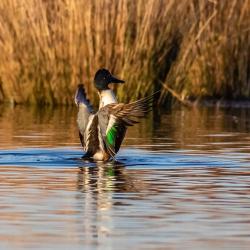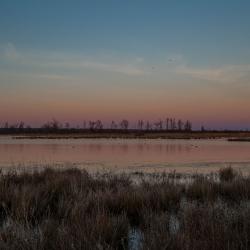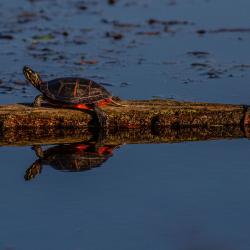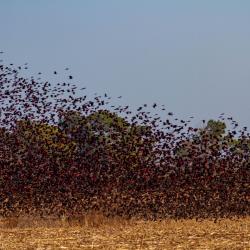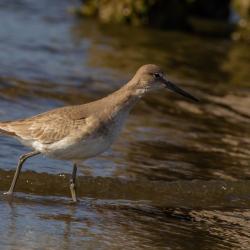After 2 years we were headed back to Pocosin Lakes National Wildlife Refuge to see some wildlife and the annual bird migration. Soon as we arrived we headed straight over to Pungo Lake, in the Pocosin Lakes Wildlife Refuge in North Carolina to see the great bird migration. We arrived early afternoon at Pungo Lake and were greeted by a robust symphony of honking Tundra Swans with a sprinkle of a variety of ducks.
Reports say the black and white migration of Tundra Swans and Snow Geese arrive at Pocosin Lakes National Wildlife Refuge in December and stay to late February. We found the biggest concentration of birds at Pugo Lake this year. We found a few Snow Geese at Pea Island Wildlife Refuge and Lake Mattamuskeet Wildlife Refuge, but the majority of them were on the lake at Pungo. On previous trips, we arrived in mid January, and they had just arrived. This year we came February 1, and it seems that we needed to arrive earlier to see even more Tundra Swans and Snow Geese.
The Pocosin Lakes Wildlife Refuge is 110,000 acres in Hyde, Tyrrell, and Washington County. It is located six miles south of Columbia, NC off Highway 94 on the east and 18 miles south of Plymouth, NC on Highway 45 on the west. The 12,350 acre Pungo Unit of Pocosin Lakes Wildlife Refuge winters a large numbers of waterfowl with peak numbers of well over 100,000 in December and/or January each year. Waterfowl species that winter on Pungo Lake include Tundra Swan, Snow Geese, and over 20 species of ducks including Northern Shovelers, Wood Ducks, Teal, Mallard, and Pintail Ducks.
The rather large Tundra Swans, which grow up to 52" tall with a 5' wing span were a kind of a nervous bunch. As you got close to Pungo Lake, they would slowly swim away to increase the distance between you and them. To help capture them, it is best to have a big lens (600mm+), stay quiet and relatively still for long periods of time, and visit when there are less people (week days, early morning.) This seemed to put them at ease, and they didn't stay quite as far away. But, we find the later you arrive in the season the further away they want to be from people. When we were looking for a little more action, we had one of us to walk quickly and purposely near them, sending them to flight, but most often, if you waited long enough, they would take off anyway.
On another visit to Pungo Lake which is a unit at Pocosin Lakes National Wildlife Refuge, we caught a whole lake full of Tundra Swans that appeared to be being harassed by a F-15 Eagle fighter jet. It kept flying over appearing to corral them to different areas. It made quite a show as they all popped up filling the beautiful azure sky. We later realized when examining our photographs that many of them were Snow Geese.
Watching these beautiful ivory birds "walk" across the water to take off was amazing and even funny at times. A group would organize and move to the back to take flight. Others would join out of panic, and as they walked across the water, they would run over anyone in their way. To our amazement nearby ducks went about their business during the stampede as a half of dozen swans marched through thrashing water everywhere. One duck wasn't so lucky. We photographed a swan stomping on a duck's head.
The best times to see the Tundra Swan on Pungo Lake is reported to be before the sun comes up and late afternoon on the lakes. The early evening can seem a little carnival like when filled with photographers. But during our visit, we were fortunate to find them throughout the day. There was a flooded field right next to Pungo Lake that they fed on in the past that appeared to be wall to wall birds. Access was shut off so regrettably we didn't get a good shot of it, and we didn't have the back and forth from field to water quite as much as in previous visits. We did find some Tundra Swans gathering in a field eating as you drive into the Pungo lake area. Much to our surprise there were three Sandhill Cranes feeding right along with them.
The Tundra Swans flock together in huge groups on the ponds and in the fields and seem to be a relatively harmonious bunch, but if you spend some time watching them you are sure spot them squabbling and chasing each other from time to time. This was a lot of fun to see.
Pungo Lake roads are impassible when muddy and will be closed. So it is best to have a four wheel drive vehicle or be willing to take a hike to take a closer look. As we drove down the passageways lined with canals, we saw an huge outbreak of turtles out sunning themselves. While we were at one of the main lakes at Pungo posted up waiting to get that great duck or swan shot, we noticed this log jam packed full of turtles. We marveled at the pure grit and persistence of this very large turtle changing a relaxing moment for the unsuspecting junior turtle troop into a log rolling contest. It was hilarious. He did it probably dozen times and didn't care who he knocked off in the process. We caught a turtle crossing the road who had a unique way of escaping us while we strolled behind him. He moved at quick pace and every other step, he would would walk with his head in his shell. It was comical.
Tundra Swans weren't the only wildlife that were found at the Pocosin Lakes National Wildlife Refuge. The wildlife refuge is teeming with Kingfishers, Great Blue Herons, Mallard ducks, Ring-necked ducks, Black ducks, Northern Shoveler ducks, Green Teal ducks, Blue Teal ducks, Mergandzers, Pintail Ducks, Pied Billed Grebes, American Coots. The Red-Winged Black Birds were in full force this year and flitting back and forth feeding in the fields as you enter Pungo Lake. The massive group moved in perfect synchronization looked worm shaped at times or a rendition of the horror movie The Birds, except beautiful. A few times we would see Bald Eagles just sitting in the middle of it, watching the frenzied activity of the Red-Winged Blackbirds. Apparently these birds are aggressive and have been known to harass much larger birds like the Bald Eagle, but it just looked like he was watching them.
We visited Pea Island Wildlife Refuge, Alligator River National Wildlife Refuge, Lake Mattamuskeet as well. Pungo Lake was the best spot for birding and photographing migration birds this year along with Alligator River National Wildlife Refuge. Surprisingly, Pea Island was the least populated for bird activity, the complete opposite in previous visits, but it was probably due to being late in the season. So we checked out the gorgeous beaches along the Cape Hatteras Seashore, Bodie Lighthouse and area restaurants. We found our new go to dining spot - Tortugas' Lie. They had good variety of menu items that were unique and packed with flavor, top notch specials, sushi, yummy homemade desserts, and great service, not to mention Guy Fieri with Diners, Drive-Ins & Dives has done a show there.
We spent some extra time at the Alligator River National Wildlife Refuge because we heard there were some interesting species of ducks there. We love the swans and geese, but the bright colored ducks are our favorites. The refuge was much larger than we originally thought, and we recommend taking time to explore it. Pocosin Lakes National Wildlife Refuge has a lot of different units to explore.
We had a few funny encounters with Great Blue Herons, who seemed to be the least bothered by people on the trip. We drove up and interrupted his hunting on the side of the road. He flew just behind our vehicle and eyed us in our rear-view mirror a bit until he decide we weren't leaving and flew away. Apparently, there is a lot of bear around there. We weren't lucky enough to see one, but we saw Northern Harriers, American Kestrels, Hawks, Bald Eagles, and some Tundra Swans.
We think it would be a perfect place to set up a blind and shoot bird photographs in the early morning. Since we are without blinds, we did the shotgun approach. We eyed some ducks further up, drove up rapidly, and fired off shots as quickly as possible to capture the action.
At Lake Mattamuskeet Wildlife Refuge, we found a variety of ducks, Cormants, Canadian Geese, Tundra Swans, Red-Winged Black Birds, Meadowlarks, heron's, egrets, and deer. Early morning seems to best to catch birds on the main pond as you enter the refuge. Later in the day they hang out the middle making it difficult to see them and photograph. As you move back further in the refuge past the park office, you have a better chance of sneaking a great shot of these beautiful birds.
We had an amazing time this year. The weather was sunny and beautiful. We got some great photographs. We observed nature in all its beauty and its comedy. We witnessed some of the quirky things wildlife do and got some much needed rest and relaxation and family time. Lessons learned were: bring a portable blind and other camouflage and target late December to early January for the next trip at Pocosin Lakes National Wildlife Refuge.
We recommend that when viewing wildlife you do so with a camera in your hand. We experience so much more odd behavior and beauty looking through a camera lens and pictures that we would have missed otherwise. We are look forward to what the next bird migration season will bring.












